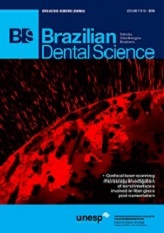Coronal bacterial leakage in root canals filled with single cone technique and different endodontic sealers
DOI:
https://doi.org/10.14295/bds.2014.v17i2.991Resumo
Objective: To evaluate coronal bacterial leakage comparing five endodontic sealers (AH Plus, Apexit Plus, Copaifera sp oil, EndoREZ and Polifil), and comparing root canals filled with EndoREZ sealer/EndoREZ® Points and EndoREZ sealer/conventional gutta-percha points.
Material and Methods: 84 human teeth were prepared and filled with gutta-percha points using the single cone technique. Roots were randomly divided into 6 groups: Apexit Plus, AH Plus, Copaifera sp oil, Polifil, EndoREZ, and EndoREZ/EndoREZ Points. After setting time, the roots were incorporated in a leakage model, which upper chamber contained a suspension of Streptococcus mutans, and lower chamber a broth. Leakage was assessed for turbidity in lower chamber for 60 days. Statistic analysis was performed using the nonparametric Kaplan-Meier method (p<0.05).
Results: All experimental groups presented leakage during the study’s period. The medium time of leakage was: Apexit Plus and AH Plus 6,3 days, Polifil 5,1 days, Copaifera 1,2 days, and both EndoREZ groups infiltrated in the first day.
Conclusions: There was no statistically significant difference between the sealers Apexit Plus, AH Plus and Polifil, but they prevented leakage better than Copaifera sp oil and both EndoREZ groups. However, none of the tested sealers was capable of resisting coronal bacterial leakage for more than 22 days.
Downloads
Downloads
Arquivos adicionais
Publicado
Como Citar
Edição
Seção
Licença
TRANSFERÊNCIA DE DIREITOS AUTORAIS E DECLARAÇÃO DE RESPONSABILIDADE
Toda a propriedade de direitos autorais do artigo "____________________________________________________________________" é transferido do autor(es) para a CIÊNCIA ODONTOLÓGICA BRASILEIRA, no caso do trabalho ser publicado. O artigo não foi publicado em outro lugar e não foi submetido simultaneamente para publicação em outra revista.
Vimos por meio deste, atestar que trabalho é original e não apresenta dados manipulados, fraude ou plágio. Fizemos contribuição científica significativa para o estudo e estamos cientes dos dados apresentados e de acordo com a versão final do artigo. Assumimos total responsabilidade pelos aspectos éticos do estudo.
Este texto deve ser impresso e assinado por todos os autores. A versão digitalizada deverá ser apresentada como arquivo suplementar durante o processo de submissão.




























